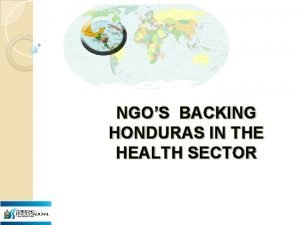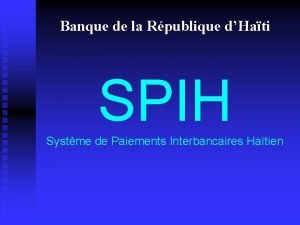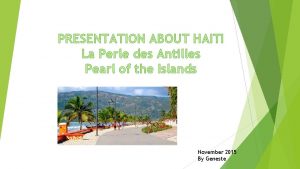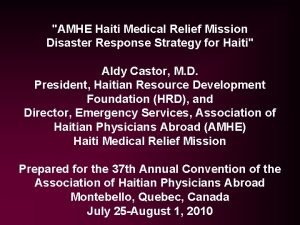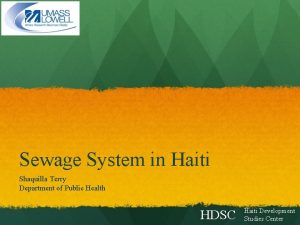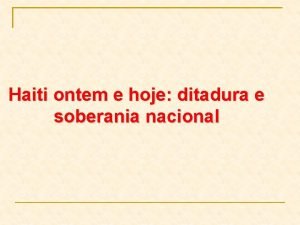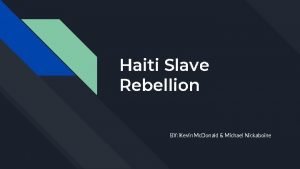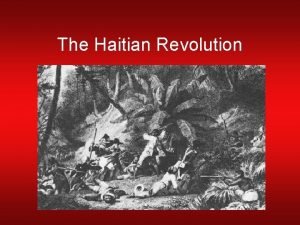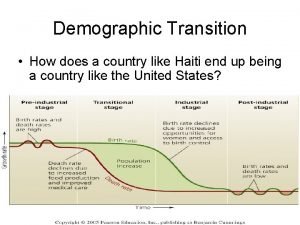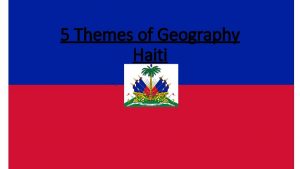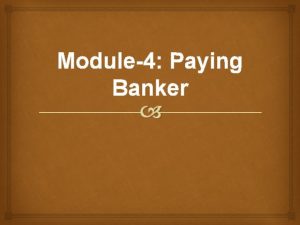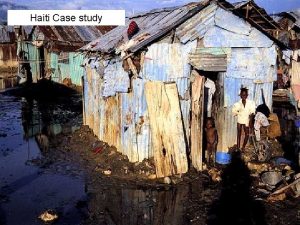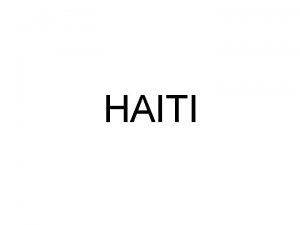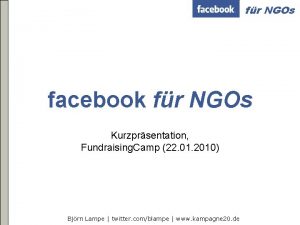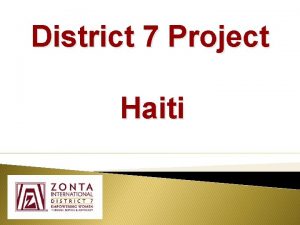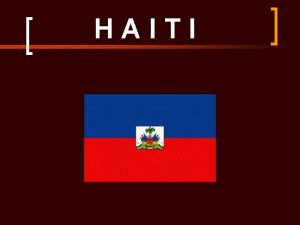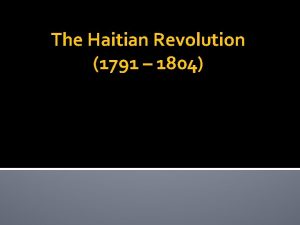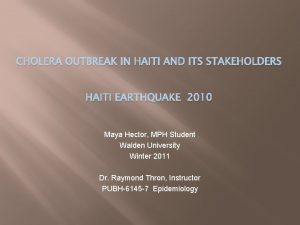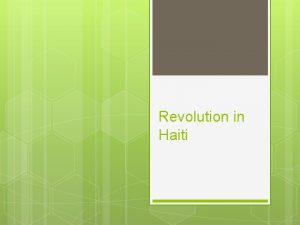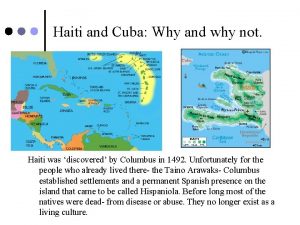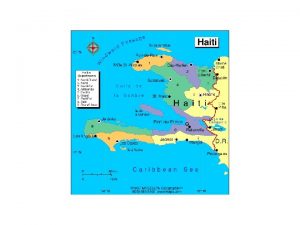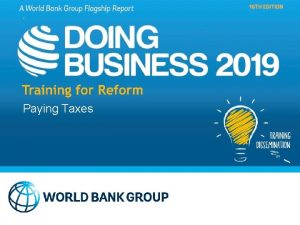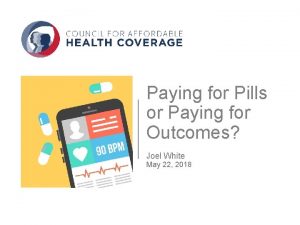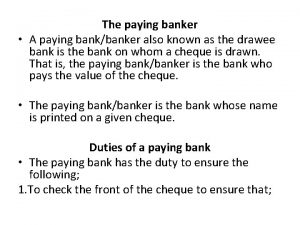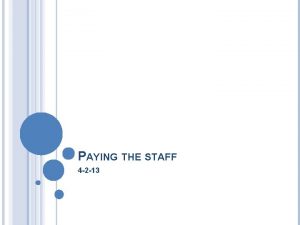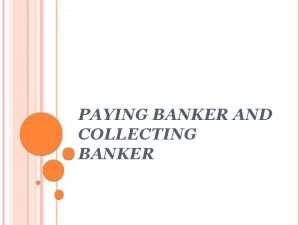Haiti Paying NGOs for results January 29 2010























- Slides: 23

Haiti: Paying NGOs for results January 29, 2010 Jaipur, India Rena Eichler, Ph. D Broad Branch Associates renaeichler@broadbranch. com.

Overview • USAID funded project (1995 -2010) to strengthen capacity to provide essential health services. • 2. 7 million people covered by 2005 • NGOs are contracted to provide a defined package of services. Technical assistance is provided to enhance institutional capacity. • Beginning with a pilot in 1999, progressively more NGOs are paid partly based on results each year. • Design changes happened along the way (indicators, targets, validation and payment rules) as more was learned. • Results from 1999 -2005 will be presented. • RBF approach continued until earthquake. Model is relevant for public payment to public facilities as well as for contracting private providers. 2

Funding mechanism before RBF Extensive and detailed budget negotiations One-year contract for service provision Initial (1 month) advance of funds NGO submission of monthly financial vouchers Cost reimbursement up to a negotiated budget ceiling • Routine financial verifications and financial audits • • • 3

Limitations of initial funding mechanism • Emphasis on securing and accounting for funds. • Little motivation to improve costeffectiveness, encourage innovation, and promote accountability for results. • Weak incentives to improve management and promote organizational development. • Weak incentives to improve clinical quality and quality as perceived by customers. 4

How did these limitations play out? • Wide variation in performance and results: 1997 Population-based survey found variations in performance (23 NGO service areas), which indicated improvement was possible. – – Full immunization coverage ranged from 7% to 70%. Contraceptive prevalence rates ranged from 7% to 25%. Prenatal care ranged from 21% to 43%. Institutional delivery ranged from 53% to 87%. • Little or no correlation between costs and results – average costs per visit range from $1. 35 to $51. 93! • Communities health needs not met • “Legitimate” excuses for non-performance • Business as usual, few innovations 5

Launch of a three-pronged strategy to improve results • Technical assistance for capacity building • Cross-fertilization for learning and technical exchange within the NGO Network • A change in payment structure from reimbursement for documented expenditures to payment based partly on achievement of negotiated performance targets 6

Results Based Financing model • Utilizes pre-established, negotiated objectives • Increased management flexibility for strategy formulation and resource allocation • Financial incentives for achieving performance targets • Financial risks for not achieving targets • Relies on independent verification of performance data by a third party • Strengthened performance management and data validation systems 7

Pilot phase in 1999 Stakeholder consultations were critical • NGOs perceived to be well managed were consulted. • Incentive based approach was presented for feedback. • Agreed that if there was the potential to earn more, some financial risk would be acceptable. • Three NGOs were chosen and agreed to be part of an initial pilot. BROAD BRANCH ASSOCIATES 8

Payment formula (pilot phase in 1999) Potential payment received by NGO = 95% of historical budget + award fee. Maximum award fee = 10% of historical budget. (Note: 5% is “withheld” and an additional 5% can be earned) In later phase, NGOs received 94% fixed and 12% “at risk” 9

Award Fee is earned when targets are reached 1999 pilots and award fee distribution Proportion of performance award earned if target achieved 10% 20% 20% 10% 10% increase in full immunization of children under 1 20% increase in pregnant women receiving 3+ prenatal care visits 15% increase in mothers with full knowledge of ORT All facilities and half outreach points with 3+ modern FP methods 25% reduction in FP drop out rate 50% decrease in waiting time for child visits establish committees that coordinate with MOH 10

Simple example • • Historic budget = $1000 Fixed portion: . 95 (1000) = 950 Award fee: . 05 (1000) +. 05 (1000) = 100 Maximum potential earnings = 1050 Payment Frequency: quarterly payments for fixed portion. Award fee paid once per year. 11

Immunization coverage (1999 pilot) 90 80 70 60 baseline target achieved 50 40 30 20 10 0 NGO 1 NGO 2 NGO 3 12

3 + prenatal visits according to MOH norms (1999 pilot) 70 60 50 baseline target achieved 40 30 20 10 0 NGO 1 NGO 2 NGO 3 13

Award Fee payment BROAD BRANCH ASSOCIATES 14

Five design and implementation phases • Phase I: Pilot phase (pilot): 1999 – Standard list of health indicators – Performance verified by independent firm with communitybased surveys • Phase II: April 2000 -December 2001 – Standard list of health indicators – NGO self-reporting complemented by validation by an independent firm • Phase III: January 2002 -December 2003 – Random selection of health indicators from an expanded list – Addition of a standard list of management indicators – 50 -50 split between health and management indicators for payment 15

Five design and implementation phases • Phase IV: January –December 2004 – Random selection from 2 “packages” of indicators including both health and management • Phase V: January-December 2005 – All NGOs in RBF, payment conditional on benchmarks plus performance targets that were the same for all NGOs, amount at risk increased to 12%. 16

Administration 1. Selecting Recipients: Before 2004 NGOs had to meet preconditions related to management, financial management and information systems, and results achieved. 2. MOUs, performance agreements and contracts: Contract Management unit designs contract template and oversees compliance with terms. 3. Results reporting, monitoring and validation: Post pilot. NGOs report results monthly to monitoring unit. Monitoring unit enters data into a tracking system. Independent auditors contracted to conduct random audits on reported data. 17

Administration continued 4. Payment Generation: Financial Management unit receives information from contract unit about targets attained as specified in contract. Contract unit receives info about achieved results from monitoring unit. Payment is triggered when results specified in contracts are achieved. 5. Assessment and Revision: Combination of consultation with NGOs, assessment of results and processes, and cross-network learning. 18

Selected indicator change (1999 -2004) BROAD BRANCH ASSOCIATES 19

Results after six years of implementation in Haiti • Introduction of RBF marked a significant improvement in NGO documented performance (against all odds) • NGOs in the project performed consistently better than all of Haiti • NGOs under RBF consistently outperformed those under cost reimbursement (in same project) • NGOs usually showed a large jump in performance between the year before RBF and the first year under RBF • Overall Project performance improved significantly in 2005 when almost all NGOs were in RBF 20

A glimpse of NGO feedback and what happens inside the black box… • Consensus that the focus on results provides incentives to strengthen information and to use it. • Financial incentives for staff implemented: One NGO establishes targets for each service delivery point, reviews data and holds discussions monthly, helps establish strategies to reach performance goals. Staff receive a 14 th month of pay if SDP target is reached. • Another NGO views RBF as a “catalyst for improved management”. • Expressed disadvantages include “institutional stress” generated by having to achieve targets and that payment for achieving each target is “all or nothing”. 21

Major Accomplishment Despite fragile government, weak infrastructure, security problems and natural disasters, innovative and flexible implementation efforts continued to provide essential health services & deliver results USAID external evaluation - 2006

Thank You!
 Ngo honduras
Ngo honduras Ngos in iceland
Ngos in iceland Role of ngos
Role of ngos Role of ngos
Role of ngos Spih haiti
Spih haiti Haiti amerique international
Haiti amerique international Haiti
Haiti Dieudonne larose death
Dieudonne larose death Haiti
Haiti Effluent pumps haiti
Effluent pumps haiti Gerdameria
Gerdameria Mc donald haiti
Mc donald haiti Oge haiti
Oge haiti Haitian revolution map
Haitian revolution map Rev cafe haiti
Rev cafe haiti Docteur frantz large biographie
Docteur frantz large biographie Haiti
Haiti Haiti demographic transition model
Haiti demographic transition model Sewage pump size calculator
Sewage pump size calculator Absolute location of haiti
Absolute location of haiti Lagonav
Lagonav Bailes tipicas de honduras
Bailes tipicas de honduras Paying banker
Paying banker Jamie has a job paying 25 000
Jamie has a job paying 25 000
